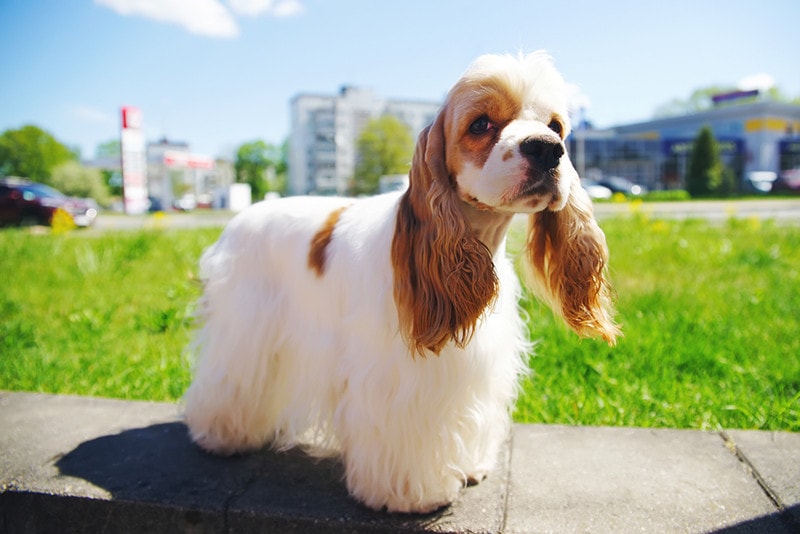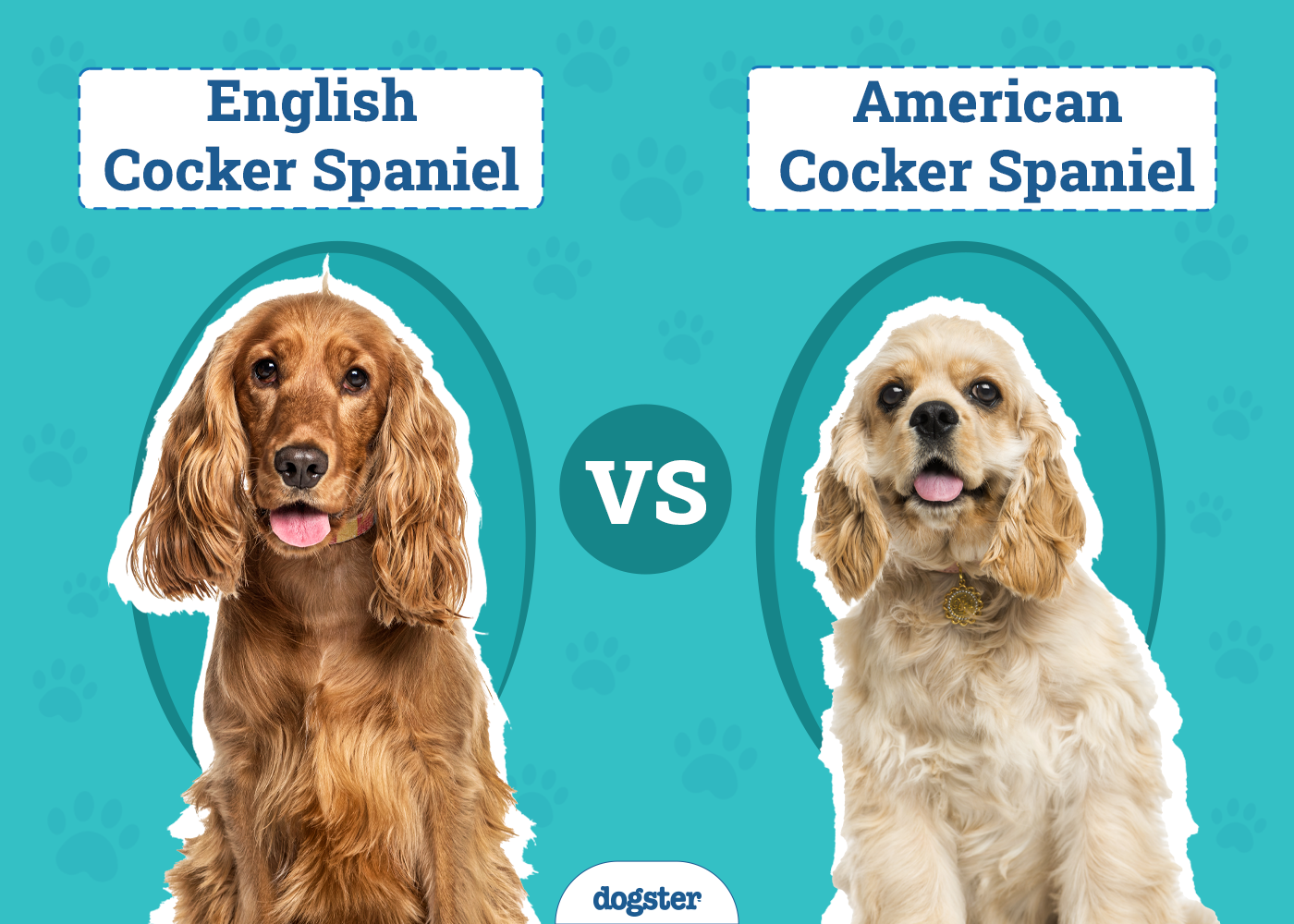In this article
Cocker Spaniels have a rich history as working gun dogs and as loyal companions. Whether working in the field or relaxing at home, Cocker Spaniels win the hearts of any who come across them. Their adoring natures led to the divergence of the English and American variants, which grew into distinctly different yet equally distinguished breeds. From the earliest mentions of the breeds in the 12th century to the working and show lines owned today, American and English Cocker Spaniels have their own loving and loyal fan bases. This article will look at both breeds in depth to help you decide which breed is right for you.

Visual Differences

At a Glance
- Average height (adult): 15–17 inches
- Average weight (adult): 26–34 pounds
- Lifespan: 12–14 years
- Exercise: 2+ hours a day
- Grooming needs: Moderate
- Family-friendly: Yes
- Other pet-friendly: Yes
- Trainability: Eager to please, intelligent, energetic, merry, responsive
- Average height (adult): 13.5–15.5 inches
- Average weight (adult): 20–30 pounds
- Lifespan: 10–14 years
- Exercise: 1+ hour a day
- Grooming needs: High
- Family-friendly: Yes
- Other pet-friendly: Yes
- Trainability: People pleaser, intelligent, bright, gentle

English Cocker Spaniel Overview

The English Cocker Spaniel is the merriest of dogs, whether the show or the working type. They are human-oriented dogs; they love their owners and strangers and are happiest with people. The two distinct types, working and show, primarily differ in looks alone. The working English Cocker has shorter fur and ears than the show version, but their temperaments are essentially the same. As a result, they’re popular dogs. They have the intelligence and eagerness to please to be excellent in working and agility trials, as well as loving pets. The English Cocker Spaniel was recognized as a breed separate from the American Cocker Spaniel by the American Kennel Club in 1946.
Personality / Character
The English Cocker Spaniel is a soft-hearted dog that is happy and kind. They are loyal dogs but not the best watchdogs since they love people too much! English Cockers are great with children of all ages, and they get along very well with other pets in the home if well-socialized. However, they do not do well on their own. While they are adaptable, you will need to spend plenty of time with them because they can suffer anxiety if they have no people around to keep them company. While the working English Cocker can be driven and focused in the field, both variants are sometimes silly and light-hearted.
Training
The English Cocker Spaniel is highly intelligent and was bred to follow commands, so they’ll enjoy training sessions almost as much as they love to play. The dogs thrive on positive reinforcement and praise from their owners; harsh correction or negative training methods will do nothing but make the English Cocker very afraid. Training them is relatively easy, but they can become easily distracted by other people. Therefore, one-on-one training sessions are ideal.

Health & Care
The English Cocker Spaniel is relatively healthy, but they have some problems that often plague purebred dogs. Their teeth should be cleaned daily with dog-safe toothpaste to prevent dental disease, and their nails should be clipped once a month.
- Ear Infections
- “Rage” Syndrome
- Progressive Retinal Atrophy
- Hip Dysplasia
- Familial Nephropathy
- Adult Onset Neuropathy
Minor Conditions
- Ear Infections: Because of the English Cocker Spaniel’s floppy ears, the dirt and wax build-up can cause irritation and breed fungus or bacteria. This leads to outer and inner ear infections, causing hearing loss, loss of balance, and pain.
- “Rage” Syndrome: Rage syndrome is a disputed condition in which sudden, random, and violent aggression is turned toward owners.1 These episodes occur entirely out of the blue and are accompanied by a glazed expression, with dogs seemingly oblivious to what just happened. This aggression has been attributed to a type of epilepsy, neurological changes, dominance aggression, and social aggression. It seems to be more common in light-colored male Spaniels.
Serious Conditions
- Progressive Retinal Atrophy: Progressive retinal atrophy is a condition that affects dogs’ photoreceptor cells in the retina. It slowly degrades the cells over time to cause blindness. Signs include night blindness, stumbling, or behavioral changes.
- Hip Dysplasia: Hip dysplasia is the malformation of the hip joint during a puppy’s growth, leading to changes in the shape of the bones and deformity. Signs include pain, reluctance to walk, changes in gait, and lameness.
- Familial Nephropathy: Familial nephropathy is an inherited disease that causes kidney damage and leads to kidney failure in young dogs. Changes to the collagen in the kidneys cause thickening and splitting, leading to kidney failure. Signs include vomiting, excessive thirst and urinating, anorexia, weight loss, and lethargy.
- Adult Onset Neuropathy: Adult onset neuropathy is a condition unique to English Cocker Spaniels, which causes progressive weakness of the limbs and other body parts, eventually ending in full paralysis. Signs include weakness in the front and hind limbs, gait changes, paralysis of the front and hind limbs, and inability to swallow.
Grooming
English Cocker Spaniels don’t need extensive grooming as American Cockers do, but their silky coats still need a good brushing once a week to keep them knot-free. Ear inspections should be a daily occurrence for them, however, as the shape of their ears is the perfect breeding ground for bacteria and yeast to grow. Gently cleaning their ears should become a routine. The English Cocker Spaniel often has longer fur around their feet, on their chest, and behind their ears that will need tidying with scissors occasionally. Still, many owners find doing this themselves perfectly manageable if they don’t wish to use a groomer.

Suitable For:
The English Cocker Spaniel is ideally suited for an active family. Families who want a loving playmate for their children that will happily match their energy will find that the English Cocker is an excellent companion. However, they aren’t suitable for owners who work away from home for long hours and are better suited to those who work from home or can take their dogs to work with them.
- Loyal and loving
- Always happy
- Intelligent and active
- Need stringent ear cleaning
- Don’t do well alone

American Cocker Spaniel Overview

The American Cocker Spaniel diverged from the English Cocker in the 19th century and rocketed in popularity to become one of the USA’s most beloved breeds. American Cocker Spaniels were the most popular breed in the US in the 1940s and ’50s, with a return to top-dog status in the 1980s. They were also popular pets of leadership, with two presidents of the United States (Richard Nixon and Harry S. Truman) owning an American Cocker. These are happy and bright dogs with beautifully flowing fur and soulful eyes. While they’re not suitable for field work anymore, they make the best companions and are just as intelligent and eager to please as their English counterparts.
Personality / Character
The American Cocker Spaniel is a lively dog that makes a merry companion for any family. They love familiar people and strangers equally, making them pretty poor guard dogs but excellent pets. The American Cocker is gentle and kind around small children and other animals if socialized when young. However, they have a mischievous streak and delight many with their antics. They love to play, and they shine most when they’re around the people they love. Because of that, the American Cocker Spaniel doesn’t do well left alone and should always be around their family.
Training
Intelligence and eagerness make training the American Cocker Spaniel easy; they respond very well to praise and a simple, disapproving tone when correcting. Harsh corrections will cause abundant fear in the gentle dogs. In fact, praise and play are almost as effective as treats regarding motivation!

Health & Care
Unfortunately, the American Cocker Spaniel is less healthy than its English counterpart and has some health conditions that potential owners should be on the lookout for. As with all breeds, American Cockers should have their nails trimmed once a month, and their teeth should be cleaned daily with pet-safe toothpaste.
- Rage syndrome
- Ear infections
- Dilated cardiomyopathy
- Phosphofructokinase Deficiency
- Invertabral Disc Disease
- Hip Dysplasia
- Progressive Retinal Atrophy
Minor Conditions
- Rage syndrome: Similar to English Cocker Spaniels, American Cockers have a higher incidence of unexpected bouts of severe aggression. This is likely due to American and English Cocker Spaniels’ links, being one and the same before the breeds became distinguished.
- Ear infections: The American Cocker Spaniel has very pendulous and hairy ears, so they are at a high risk of developing multiple yeast or bacterial infections in their inner and outer ear.
Serious Conditions
- Dilated cardiomyopathy: Dilated cardiomyopathy (DCM) is a condition in which the heart muscle degenerates and degrades, leading to thinner walls and an enlarged heart. This condition leads to heart failure and is characterized by rapid breathing, trouble breathing, blue gums or tongue, exercise intolerance, and collapse.
- Phosphofructokinase Deficiency: Phosphofructokinase deficiency is a deficiency in an important enzyme that converts glucose into usable energy in the body. Signs of this condition include fever, exercise intolerance, blood in the urine, lethargy, and muscle weakness.
- Invertabral Disc Disease: Invertabral disc disease is a degenerative disease that affects a dog’s spinal cord, causing the discs that sit in the spine to bulge, rupture, or herniate due to hardening.
Grooming
The American Cocker Spaniel’s long-haired coat needs daily grooming to free it from knots and tangles. Even one missed grooming session can mean hours spent untangling, so a ritual of combing, brushing, and detangling is a daily affair. Their ears need careful cleaning and drying daily to prevent yeast or bacterial infections (ask your vet the best way to do this for your dog), and a visit to a groomer once a month is advised to keep their flowing coats trimmed and keep them comfortable.

Suitable For:
American Cocker Spaniels are suitable for families that want a joyous, loving companion who will love to play as much as the children do. They thrive on human companionship, so owners who work from home or who can take their dogs into the office are the best fit.
- Joyous
- Loving
- Good with children
- Need extensive grooming and ear care
- Cannot be left alone

Which Breed Is Right for You?

So, now that you know more about what makes the English Cocker Spaniel different from the American Cocker Spaniel, which breed suits you the most? If you want a companion with simple grooming needs, the English Cocker is for you. However, if you want a smaller, beautifully furred but just as joyous family companion, the American Cocker Spaniel would suit you perfectly. The Spaniels have similar temperaments and make excellent companions for families with children and other pets. Just remember that both breeds can suffer from separation anxiety and need lots of attention to thrive!
Featured Image Credit: Top – Eric Isselee, Shutterstock | Bottom – Olga Aniven, Shutterstock


















